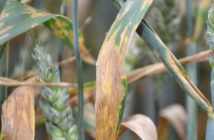The UK cereals industry is one step closer to gaining access to one of the world’s largest barley markets following an inspection visit organised by AHDB Cereals and Oilseeds.
In the last fortnight, the AHDB Cereals and Oilseeds Exports team (BCE) has hosted four Chinese government inspectors on a tour of the UK cereals supply chain, as part of a five-year project to remove trade barriers to the country’s 6Mt barley import requirement.
The visit, which is being hailed a success by those involved, could mean the UK will be able to export barley to China in future seasons.
Currently, UK barley cannot be exported to China as a ‘protocol’ is not in place, unlike just six other countries worldwide – Denmark, France, Argentina, Australia, Canada and Ukraine. AHDB Cereals and Oilseeds has led the initiative to gain the necessary protocol under its remit of accessing markets and removing barriers to trade.
Exports (BCE) Manager Sarah Mann said: “This is a significant achievement representing five years of work and a huge collaborative effort from across the sector.
“We’re not quite at the finish line but this is an important step in the process, showing that China and the UK have reached an understanding about how to proceed on what could be a lucrative opportunity for grain exporters.”
A key part of the process was demonstrating to inspectors that the UK barley supply chain is governed by a competent authority and export cargoes would be free from pests, diseases and weeds.
Having passed the first stage of the risk assessment by providing information on UK production systems and supply chain processes to AQSIQ (General Administration of Quality Supervision, Inspection and Quarantine, People’s Republic of China), AHDB Cereals and Oilseeds hosted the June visit for inspectors to audit UK processes and demonstrate that the measures in place are adequate for Chinese requirements.
Farm and trade assurance schemes were used to show how processes relate back to legislation and how hygiene controls are enforced across the barley supply chain.
Ms Mann added: “They were pleased with what they saw; they commented that our systems are well managed and recognised that the assurance schemes played an important role in ensuring the quality and safety of grains in the UK.”
Those involved included Gafta (Grain and Feed Trade Association), AIC, APHA (Animal and Plant Health Authority, part of Defra), FERA, the Plant and Seed Health Inspectorate, Defra, Scottish Government, SASA (Science and Advice for Scottish Agriculture, part of Scottish Government), RPID (Rural Payments Inspections Division, part of Scottish Government), Red Tractor Farm Assurance, and Scottish Quality Crops (SQC).
The tour included visits to farms, stores and the official testing laboratories for England and Scotland.
Exports (BCE) Chair Mike Hambly said: “This has been a challenging process as industry self-regulation is not well-understood by the Chinese.
“It is a testament to the professionalism, robustness and integrity of the assurance schemes and their members that the inspectors seemed satisfied at the end of their visit. These are exciting times for barley growers and traders.”
The inspectors will now submit a written report to be considered by AQSIQ, which will determine the terms of the protocol. The protocol could be in place within months or may take much longer, depending on the complexity of negotiations.
The AHDB Cereals and Oilseeds Exports (BCE) Committee, made up of representatives from across the cereals industry, took the strategic decision to pursue the Chinese protocol due to an increase in population, urbanisation and wealth signalling strong market potential. In addition, Chinese feed compounders are looking to include barley in their animal feed rations to replace 20Mt of maize, as a result of high domestic maize prices due to China’s internal stock-piling policy and import tariffs.
AHDB Cereals and Oilseeds Chair Paul Temple added: “Chinese import requirements are rapidly increasing – in 2012 China imported less than 2Mt barley; in 2015 it is forecast to be 6Mt. With UK barley production increasing, this is the ideal time to open the door to a market with potential for demand growth.
“If we can facilitate that happening, it will be up to growers and exporters to respond to that demand and take advantage of the opportunities it affords.”



